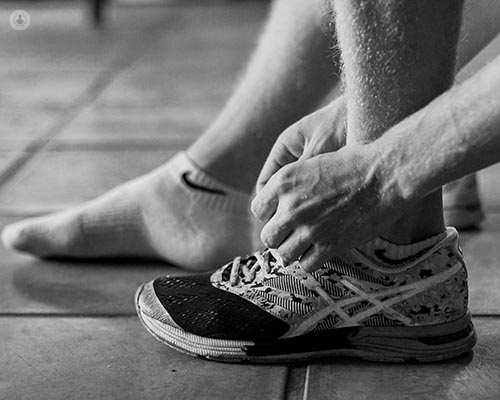Ankle instability: what are my treatment options?
Written in association with:Ankle instability refers to a condition where the ankle lacks the ability to maintain its normal position during weight-bearing activities. It is often caused by ligament damage due to injuries, leading to recurrent episodes of giving way or rolling of the ankle. Distinguished consultant orthopaedic surgeon Mr Vail Karuppiah provides a guide to both surgical and non-surgical options for addressing ankle instability.

What is ankle instability surgery, and how is it performed?
Ankle instability resulting from sports injuries is quite common. While most patients respond favourably to physiotherapy and strength training, a minority may require surgical intervention.
The instability arises from torn ligaments, crucial for stabilising the ankle during demanding activities like contact sports, running, and walking on uneven surfaces. Surgery seeks to restore stability by reconstructing these torn ligaments.
Are there any non-operative/non-surgical treatment options?
Physiotherapy offers a preferable alternative to surgery, focusing on strengthening the lateral tendons to serve as secondary stabilisers. This remains the primary treatment approach. Alternatively, wearing a robust ankle brace during strenuous activities, like sports, is an option. However, if there's substantial ligament damage, such as extensive tearing, non-surgical management is not as effective.
What is the typical recovery process after ankle instability surgery?
The typical recovery process takes about 2-4 weeks, starting with some simple rehabilitation, which includes swimming and cycling. It is expected that most patients can begin with contact sports 6-8 weeks after surgery.
What does the surgery entail and recovery process?
Surgery for ankle instability involves reconstruction of the torn ligament under anaesthetic. It is performed as day case procedure and the patient will be post-operatively mobilised with a special surgical boot for 4 weeks. During this time patients can put full weight with the help of some crutches.
What are the common rehabilitation exercises recommended after ankle instability surgery?
Post-surgery ankle ligament rehabilitation follows a structured approach. The first 2 weeks prioritise rest for wound healing. Then, gentle range of motion exercises are introduced. At four weeks, physiotherapy begins, with a focus on stretching, balance, and strengthening exercises for the following 2-4 weeks.
What are the potential risks and complications associated with ankle instability surgery?
Every surgery carries inherent risks. It is important to recognise that post-operative swelling, pain around the surgical site, and stiffness are quite common for a few months, but will improve over time.
Although uncommon, potential risks associated with the surgery include infection, blood clots in the leg or lung, swelling of the foot and ankle lasting up to 3 months or more, oversensitivity of the scar, injury to major nerves or blood vessels near the surgical site, temporary or permanent numbness in the area. Chronic pain (CRPS), limb loss, and anaesthesia-related complications can also occur, although it is highly unlikely that these risks will occur.
If you require surgery for ankle instability and would like to book a consultation with Mr Karuppiah, simply visit his Top Doctors profile today


